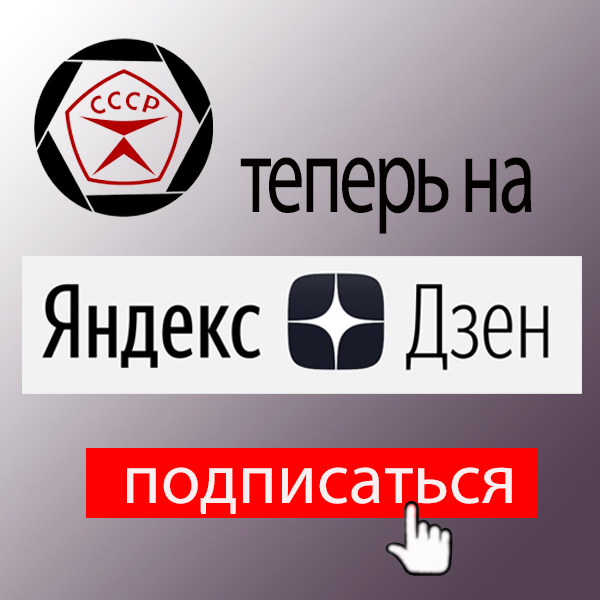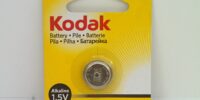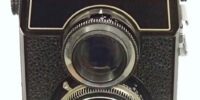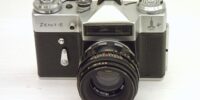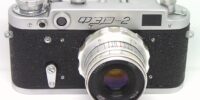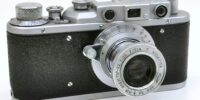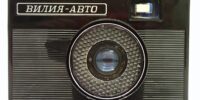Zorki camera USSR, review and manual
–
Zorki (“Зоркий”) is a rangefinder camera for 35 mm film produced by the Krasnogorsk Mechanical Plant (KMZ).
In this case, I mean the first model of Zorki. The index “1” was not indicated in the title, but for the sake of clarity, one can also say Zorki-1.
In principle, Zorki-1 is a copy of the pre-war FED camera (also the first model and we can also say FED-1), which in turn is a copy of the German Leica II camera.
The history of the appearance of the FED brand is described in my separate large article, we will not repeat ourselves here.
I will only say that before the start of the Great Patriotic War, FED cameras of the first model were produced in the city of Kharkov at the F.E. Dzerzhinsky Machine-Building Plant. With the beginning of the Second World War, the plant was evacuated and the production of civilian photographic products was interrupted for the period of the War.
After the end of the Second World War, all spheres of peaceful life had to be reorganized, including the production of cameras.
FED-1 was somewhat outdated, but quite adequate for that time model. In addition, its production was completely debugged, because before the Second World War, about 180 thousand copies were produced.
This device perfectly suited the task of quickly meeting the needs of the economy in a functional and inexpensive photographic technique.
Kharkiv was badly damaged during the Second World War and it took time to restore the industrial infrastructure in the city. It was decided to launch production of FED-1 at two enterprises at once – at the restored Kharkov machine-building plant FED and at the KMZ near Moscow.
Who was the first?
Strictly speaking, the first post-war FEDs were assembled at the facilities of the Dzerzhinsky Plant in 1946. About 1800 pieces. True, it was still in the evacuation. This refers to the real Berd FEDs of the NKAP-USSR (“НКАП-СССР”).
If you look at the place of permanent production, then the championship is for KMZ.
It was there, at the end of 1947, with the support of FED specialists who returned from evacuation, and, possibly, using ready-made Kharkov or Berd components, that the first FED cameras were produced in Krasnogorsk.
In Kharkov, however, production resumed not much later – from 1949.
Now I will not dwell on the very first issues of Krasnogorsk FEDs of 1947-48. This is very interesting, but we will postpone it until the advisory review.
The name “Zorki”, which means “sharp-sighted” in Russian, did not appear immediately. The first issues of Krasnogorsk FEDs were called “FEDs”. Then the name “FED-Sharp” appeared and only a little later – just “Zorki”. Photo from sovietcams.com. Please note that the KMZ emblem (this is a Dove prism) at first did not have ray tracing arrows. Therefore, she quickly received the nickname “Coffin”.
“Zorki” is the unofficial name of the workers’ settlement at the optical plant, on the basis of which Krasnogorsk was founded. “Zorki” was the codename of the plant in telegraph messages during the Second World War.
In 1949, the name “Zorki” was more related to the enterprise than to the brand of the camera. Further, with the advent of Zenit devices, the enterprise has already become associated with them. So, the devices with the name “Zorki” were produced from 1949 to 1956.
Experts identify quite a few modifications of the first Zorki, but listing all of them is beyond the scope of my site. Therefore, I will focus only on the main milestones in the development of the model.
Since 1949, the top cover of the Zorki camera looked like this: the name “Zorki”, the plant logo and the number. Photo from sovietcams.com.
Old standard shutter speed set: 1/20, 1/30, 1/40, 1/60, 1/100, 1/200, 1/500, Z. Models from 1947-48 could have 1/1000, but now speech not about them.
From the 49th year, the release button received a nest for a cable. Before that, it was solid.
1951-52 (sources differ slightly) for the production of camera bodies and shutter parts, injection molding began to be used.
From this point on, smooth black decorative stripes appear between the chrome parts and the vulcanite.
The strength and dimensional accuracy of the Zorkis cases are significantly increased.
Here I want to dwell on this moment.
Literally in all sources there is a phrase of this type: “At the KMZ, the tolerances for the working distance were immediately tightened – 28.8 + / – 0.03 mm, which made it possible to exclude the operations of individual adjustment of lenses for a specific camera”.
In my opinion, thanks to this phrase, repeated without any special context, a somewhat distorted idea is formed that the working segment was terribly “wandering” in FED devices and therefore the use of interchangeable optics did not make sense.
I have seen similar opinions. And the range of working segments is carried over in opinions even to FED-2 and Zarya, whose body is also cast.
I do not have data on the tolerances of working segments in FED cameras (maybe someone has this information, please share).
Let’s think about it.
Before 1935, there really was an adjustment window in the rear wall of the FEDs.
Since 1936, it disappeared, and from that moment on, it became impossible to talk about any individual adjustment, because the back wall is not removable.
At the same time, the fleet of interchangeable optics was quite solid. How to use it if you need to adjust, but impossible?
I believe that after 1936 the problem of the scatter of the working distance on the FED chambers was sufficiently solved.
Next.
Until 1952, Zorkis cases were produced using the same technology as FED cases – from a flattened aluminum tube.
Probably, at KMZ, this technology was improved against the pre-war one. But in Kharkov, the production was rebuilt and most likely the equipment was more modern and accurate.
In general, I will assume that the phrase about the tightening of tolerances on the working lengths on the Zorki cameras refers either to the pre-war situation or to the new cast hulls. I think it’s impossible to say that the working segment of the post-war Zorkis was much more accurate than that of the post-war FEDs. GOST is for that and GOST.
But we got distracted.
From 1953-1954, the Zorki room moved from the top cover to the back wall. The decorative smooth frame around the lens has also been expanded.
Since 1955, the device has received an updated set of shutter speeds: 1/25, 1/50, 1/100, 1/250, 1/500, B. But this is not the most modern version yet.
Also, from 1955, a new seven-digit numbering began to be applied. The first two digits in the number began to indicate the year of issue. Prior to that, the number was through. With such a system of numbers, cameras were produced only for 2 years 1955 and 56. All this can be seen on the instance in the review.
In 1956, Zorki was discontinued.
During the 50s, Zorki devices were periodically produced with a double name in Cyrillic and Latin letters: “Зоркий/Zorki”. These are most likely export versions. Modifications with a double name can also differ from each other in design details. Photo from sovietcams.com.
Since 1948, Zorki was not for long the only domestic narrow-film camera available (conditionally) for sale. The only alternative was in the person of Komsomolets and two models of the Moscow camera. First and second.
I don’t think it’s true that many of them were released. The cameras of the 48th edition are very rare now.
In 1949, the first post-war FED was released, and until 1951, these two identical, in fact, devices were the only option for a photographer with a narrow film.
Then the release of Zorki-3 (from 1951) and Zenit (from 1952) began – there was already a choice and competition. Conditional, of course, since cameras were in short supply.
At the time of the discontinuation of production of the first Zorki in 1956, there was already a full range of its improved modifications (-2, -C, -2C) on the shelves, all variants of Zorki-3 and even Zorki-4.
FED-2 was also on sale, which looked more than advantageous against the first Zorki.
In 1956, the camera Leningrad was released, but this is a device of a significantly higher level.
The Zorki cameras of the first model were released a lot – they almost made it to a million. Late models are massive and inexpensive devices.
However, with instructions and passports, they are much less common. For pieces of paper, 70 years is still a period.
Further, the earlier the device is released, the less frequent it is. 1948 goal variants are very rare.
In the review today, a copy of 1955 is in excellent condition with the number 5559352. According to the classification of sovietcams.com, this is ZORKI-1 (E) PM1125.
This model was produced from 1955-1956, it is located in the range of numbers from 55 45 000 to 56 35 000. The volume of production of the modification is about 240 thousand copies.
First, I would like to thank our Patreons on the Patreon platform. Thank you for helping the project develop.
Zorki-1 camera
Zorki-1 was produced at KMZ from 1947 to 1956. The total release of all modifications amounted to about 835 thousand copies.
The standard lens is a folding Industar-22 3.5 / 50.
Optics mount type – M39 × 1 thread. Focal length 28.8 mm.
Shutter – curtain, cloth. For this modification, the shutter speeds are 1/25, 1/50, 1/100, 1/250, 1/500, В.
If you press the shutter release button and turn the rewind lever at shutter speed B, you get a long shutter speed “Д”.
The camera is not equipped with a self-timer and sync contact, although it does have an accessory bracket.
The weight of my copy with a standard lens is 505 grams.
Control elements:
The first Zorki is indeed very similar to the very first post-war FED.

Here are two devices of comparable years of release. Find the differences. Well, if you don’t look at the lens.

The camera is very compact. All subsequent models of Zorki were larger. About DSLRs – I am silent.

In front, in addition to the lens, three windows are visible.
In the center – rectangular – this is the viewfinder. On the sides are round – rangefinder. Rangefinder base 38 mm.
In the first Zorki cameras, the rangefinder was not combined with the viewfinder. To take a picture, you need to do something like this: looking through the viewfinder, select the desired distance to compose the frame. Looking through the rangefinder – focus on the desired object. Looking through the viewfinder again – to finally position the frame boundaries in accordance with the composition.
That is, it was often required to put the eye to the viewfinder, then to the rangefinder several times.
There are two eyes on the back.
The right one is from the viewfinder. The viewfinder of the first Zorki gives a small (x0.44 magnification), but quite bright and clear picture.
The left one is from the rangefinder. The picture in the rangefinder is round, has a real scale and a rather narrow field of view. The picture in the rangefinder does not give an idea of the frame boundaries.
The image in the rangefinder is slightly tinted blue. The central area, in which, in fact, two images are superimposed, is lighter and slightly yellow.
In general, the rangefinder is quite comfortable to use.
The main controls are concentrated on the top bar.
From left to right are located:
- lifting head of rewinding;
- “cold” bracket for flashes;
- the head of excerpts;
- release button;
- in front of the button there is a shutter release lever when rewinding;
- head of shutter cocking and frame transport with frame counter.
To change the shutter speed, you need to raise the crown, turn to the desired value and release. The index arrow is located to the left of the head on the accessory bracket.
You can change the shutter speed only when the shutter is cocked! When the shutter is cocked, the shutter speed dial rotates and the index indicates the correct shutter speed only if the shutter is cocked.
The bottom of the unit has a bottom cover lock (left) and an old 3/8 inch tripod socket (right).
To charge the film, you need to open the lock and remove the bottom panel. On the left, it is fixed with a lock, and on the right, it is put on a pin on the side of the device.
My attitude towards the camera:
Studying materials about the first post-war Zorki, as well as about FEDs, or just recently there was a review of the second Moscow, I am personally amazed at how quickly (1946-47) the country was able to establish the production of photographic equipment after the Second World War. Products are not the first necessity.
That’s all for me, good luck!
This is a link to the site’s Patreon channel. Join and support the project!
Lenses from many Soviet cameras, including this one, can be used with digital cameras. To do this, you need an adapter. The cheapest adapters are sold on Aliexpress. The table will help you choose an adapter for your system.
Attention! With a DSLR, the rangefinder lens will only work in macro mode. Full use is possible on a mirrorless.
Some lenses have important specifics. Look first for a review on my site. And don’t forget the crop factor.
| Type | Brand | URL |
| DSLR | Nikon | M39-Nikon F |
| Canon | M39-Canon EF | |
| Sony | М39-Sony/Minolta | |
| Pentax | M39-pentax K | |
| mirrorless camera | Sony | M39-NEX |
| Оlympus/ Panasonic | M39-m 4/3 | |
| Fuji | M39-FX | |
| Nikon | M39-Nikon 1 |
Manual (thanks to eugigufo.net):






































